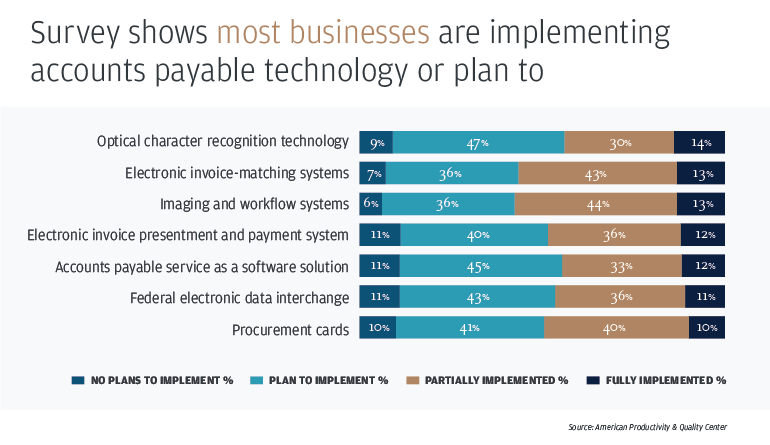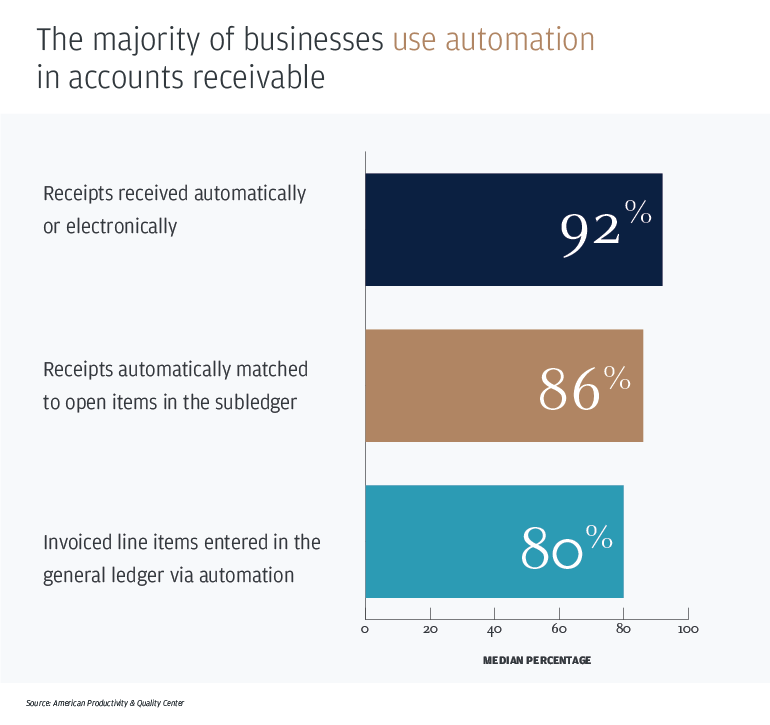
Technology is integral to treasury functions, including accounts payable and receivable. Even if your treasury has already streamlined processes, you may be able to further automate tasks to free up time for more strategic thinking.
To keep organizations running smoothly, treasury departments should look closely at their technology systems and where they can improve. Once you know where your technology infrastructure stands, you can make a case for change.
Determine the systems and software you need
A successful transformation will involve making the most of current technology resources and, when necessary, consolidating or replacing resources. Determine the software and systems that best support your processes. For example:
- Enterprise resource planning (ERP) software can help automate day-to-day activities. For example, invoice creation, invoice disbursement and posting rules can remove manual tasks in the order-to-cash cycle. Likewise, automated invoice capture, invoice approvals and payment file creation can automate the procure-to-pay cycle.
- Treasury management systems (TMS) can support and automate cash positioning and forecasting activities.
- Optical character recognition (OCR) technology can help transfer invoice information into your ERP for approval and payment processing.
- Electronic account validation can automatically query account status to ensure accounts are active and ready to receive payments.
- Receivable’s platforms and customer portals can help match remittance information to payments
- Workflow tools can collect customer information and documentation that can facilitate the approval process, for example, via vendor creation and purchase orders.
- APIs can help you integrate payment and banking functionalities into your ERP.
Getting organizational buy-in
First, consult all the departments—accounts payable, accounts receivable, accounting, IT and any others—that will be impacted. Collaboration with those groups can help clearly define your proposed solutions and determine performance metrics. Be sure to tie the performance metrics to specific benefits for each team to help you gain their buy-in.
Then, you can approach leadership. Frame the investment as part of the organization’s long-term, strategic goals. Clearly detail:
- The benefits of investing in new treasury technology
- The budget for the new systems and software
- The return on investment your organization can expect


The benefits of implementing new treasury technology
When seeking organizational buy-in, it’s important to detail what you’re hoping to accomplish with the new technology. Is it designed to save on costs, increase revenue or decrease tech debt?
Benchmarking can be especially helpful here.
In an American Productivity & Quality Center (APQC) survey, for example, almost half of the respondents leverage OCR, and more than half leverage invoice matching systems for their accounts payable processes. Accounts receivable processes are also commonly automated—just 8% of respondents still use manual spreadsheets.
You want to show leadership not only why it needs to invest in technology, but why it needs to invest now. While the drivers will vary depending on your organization, the new systems could help the business:
- Save time, employee resources and other costs
- Meet its long- and short-term strategic objectives
- Attract top talent by demonstrating a commitment to invest in the company
- Discover new training resources to reduce errors/inefficiencies
- Safeguard itself with fraud prevention controls and increase business resiliency
The ROI your organization can expect
Look at the costs and benefits of your new treasury systems. Make sure to factor in your organization’s current investments. You may also want to prepare two budget estimates that represent the best- and worst-case scenarios. If your business case still succeeds under the worst-case scenario, it will be a strong case.
Evaluate the costs
Now, you need to detail the costs, including hardware, software, support, maintenance, staff, upgrades and operating expenses. Start with the total cost of the contract, which is composed of five key calculations:
- Provider’s charges: These are charges related to the cost of the system, such as licensing of the software, development, IT and platform support. For transparency, it’s best to show the provider’s charges separately in the business case.
- Management costs: The cost should include strategic and tactical governance, measuring and evaluating performance, reporting and resolving.
- Transition costs: Examples include equipment leases that are not transferable due to the provider’s solution or restrictive lease provisions and office and facility leases that will now be vacant space, requiring time to be sublet or renegotiated.
- Startup costs: These are the expenses associated with an organization’s FTE costs to support the rollout of the new technology.
- Exit costs: These costs cover the actions and events necessary when leaving a provider or transitioning functions to a new vendor.
Factors that may increase your ROI
- Breadth: More people using the new software or system means more bang for your buck.
- Frequency of use: Your ROI climbs as the technology gets used more often.
- Cost of task: The more costly the treasury task, the greater the benefit from automation or technology investment.
- Ease of collaboration: Communication between employees is costly, so the easier the software or system makes collaboration, the greater the potential ROI.
What you could gain
Assessing the benefits of your new treasury systems is often less straightforward, since some gains may be productivity based. Although these benefits are indirect, they can impact headcount. For example, new software may reduce the number of employees needed for a task or increase employees’ output, eliminating the need for new hires.
To fairly account for productivity gains, you should correct for inefficient transfer of time. The total time saved rarely equals the total additional work performed. Follow three rules to measure inefficient transfer of time:
- Measure based on total project cost.
- Account for inefficient transfer of time using a value of 1.0 for line workers to 0.5 for general employees.
- Find a corroborating measurement that supports the change. For example, if the legal department saves 10% of its time, do you expect it to lay off 10% of the lawyers or increase its productivity by 10%?
To improve your calculations, you can also:
- Survey users and average their time estimates.
- Find case studies or similar examples to better understand the scale of benefits.
- Look for industry benchmarks that can provide guidance on an appropriate estimate for your company.
- Calculate the ROI twice, once for the expected return and once for the worst-case scenario.
- Run different scenarios. For example, what if the consultants don't finish on time? What if one division refuses to participate? This can provide a clearer view of how closely you need to track key project elements as you deploy.
We’re here to help
The J.P. Morgan Corporate Treasury Consulting team can help you and your company evaluate its current treasury software and systems and find technology that best fits your needs.
© 2022 JPMorgan Chase & Co. All rights reserved. JPMorgan Chase Bank, N.A. Member FDIC. Visit jpmorgan.com/cb-disclaimer for disclosures and disclaimers related to this content.







